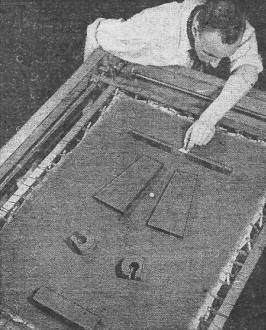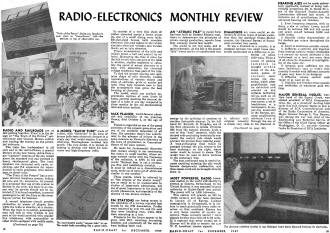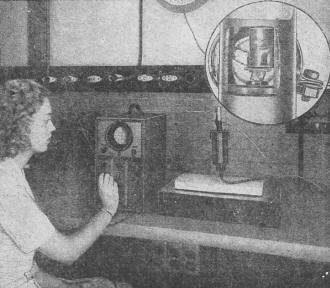Radio Electronics Monthly Review
|
|
Imagine if engineers used physical mock-ups of semiconductor substrates with BB-sized metal balls representing electrons and holes to design the next whiz-bang transistor. You'd think they were insane. Seventy-three years ago, before powerful computers and software were available to simulate the physics, engineers were doing just that sort of thing to figure out how to design vacuum tubes. This "Monthly Review" feature in the December 1947 issue of Radio Craft magazine has a photo of one of the models. Hills and valleys in the base represented voltage potentials that influenced the trajectory of the balls. Pretty clever, really. Also reported was the death of world-famous physicist and originator of the quantum theory, Mr. Max Planck. He was 89 years old - not bad for the era. A 1 MW transmitter - the most powerful in the world, was soon to built by the U.S. in Switzerland. See the page capture for all the news. Radio Electronics Monthly Review A Model "Radio Tube" made of rubber, with "electrons" in the form of bronze balls tests electronic designs in a single day that would require 3 months otherwise, Westinghouse revealed last month. The new model, it is stated, is helping to develop new tubes for television and high-frequency radio. It consists of a very thin sheet of rubber stretched across a frame about the size of a small dining room table. BB-shot-sized bronze balls simulate electrons; hills and valleys in the rubber simulate electrical voltage; and wooden blocks act as tube elements. Proper arrangement of the hills and valleys direct a ball and control its velocity. Measuring the time it takes for the ball to roll from one part of the table to another, enables engineers to calculate the speed of actual electrons in a tube. This determines the electrical voltage needed for that part of the tube. To find the proper spacing and optimum shape of tube elements wooden reproductions of various shapes and sizes of cathodes, grids or anodes are used. They help research men to find the arrangement that gives the best focusing of electrons. The model, which can produce approximate replicas of most kinds of tubes, permits checking the internal design of a tube in one day compared to three months by the old mathematical trial and error method.
Planck is regarded as one of the great scientists of the present generation and one of the scientific immortals of all time. His quantum theory has contributed to the advance of science in the same measure as Newton's discovery of the laws of gravitation or Copernicus' theory of the solar system. He made his fundamental discovery that radiant energy is not continuous, but comes in small bundles, whose energy content varies with the frequency of the radiation, in 1900. In his own words "Radiant heat is not a continuous flow and indefinitely divisible. It must be defined as a discontinuous mass, made up of units all of which are similar to one another." These quanta, which he referred to as "the pennies of the atomic world," are so small as to be unobservable in studies of large-scale phenomena, but are of great importance in the study of atomic phenomena, and especially of the physics of the atomic nucleus. Most Powerful Radio broadcast station in the world will shortly be erected at Geneva, Switzerland by the United Nations, it was reported 'on good authority to Radio-Craft last month. The power will be 1,000 kilowatts. This station will operate on 250 kc (1200 meters) and has been designed to blanket all of Europe. Located strategically in Switzerland, it is certain to reach practically every radio receiver on that continent. Europe has a very large number of crystal receivers. These normally cannot receive signals farther than from 25 to 50 miles. It is expected that every crystal set in Europe will be able to receive the new U. N. broadcast station signals. Diamonds are more useful as detectors of certain types of atomic radiation than the standard Geiger-Muller counter the National Bureau of Standards revealed last month. To use a diamond as a counter, it is clamped between two small brass electrodes maintained at a difference in potential of about 1000 volts. When a source of gamma radiation is brought within range of the diamond, pulses of current occur across the electrodes, which after amplification may be detected and counted on any suitable indicating device, such as an oscilloscope, a current meter, a set of headphones, or a loudspeaker. In apparatus assembled at the Bureau, primary amplification is effected with minimum loss of original intensity through the use of a triode very close to the diamond in the circuit. The output from this tube is then applied to a two-stage amplifier, from which pulses of sufficient magnitude to operate the detecting instrument are obtained. The pulse-producing property of the diamond is thought to be a result of its highly symmetric crystalline structure, characterized by a very regular arrangement of carbon atoms with relatively large intervening spaces. According to this theory, when a photoelectron is emitted by a diamond atom as the result of the absorption of gamma radiation the freed electron is accelerated through the interatomic space toward the positive electrode. Within a very short distance it acquires such high velocity that other atoms along its path are ionized by collision with the release of additional electrons, which in turn are accelerated in the same direction. This multiplication of charges repeats itself in rapid succession, producing a sudden avalanche of electrons equivalent to a small pulse of current. The larger the diamond the more electrons would be involved in the sudden pulse. Apparently the diamond quickly recovers from its ionized state, as the pulses registered are extremely sharp. The diamond counter is thus a very fast counter, capable of indicating a much greater number of pulses per minute than is possible with the ordinary Geiger-Muller counter. Diamonds tested in the Bureau's laboratories have been found to have a sensitivity per unit volume equal to or greater than that of any counter constructed by man. One of these diamonds, measuring about 1/8-inch on each face, has approximately the same sensitivity for gamma radiation as a laboratory-constructed Geiger-Muller counter of the usual type. Many diamonds are larger and would be more sensitive.
Posted December 17, 2020 |
|



